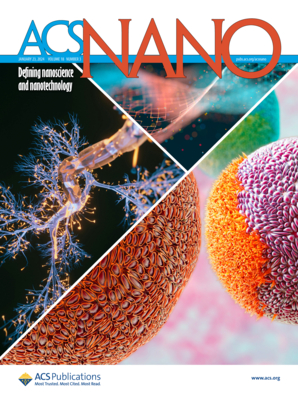Magnetoresponsive Cellulose Nanofiber Hydrogels: Dynamic Structuring, Selective Light Transmission, and Information Encoding
IF 15.8
1区 材料科学
Q1 CHEMISTRY, MULTIDISCIPLINARY
引用次数: 0
Abstract
Angle-dependent light reflection is a common phenomenon in nature, typically arising from the spatial arrangement of biological or mineral structures. Various strategies have been developed to replicate these assemblies, particularly to achieve structural color through bottom-up self- and directed assembly. However, dynamic control of light reflection remains a significant challenge. In this study, we present TEMPO-oxidized cellulose nanofibers modified with magnetic nanoparticles (approximately 10 nm in size) that exhibit rapid, directional alignment in aqueous media under magnetic fields, resulting in angle-dependent light reflection. By combining magnetic field manipulation with gas-phase hydrogelation, we were able to arrest the hydrogel structure, preserving the nanofibers’ spatial and temporal orientation. This system enables the creation of on-demand optical patterns, which we demonstrate through selective light transmission and reflection, offering potential for applications in information coding, storage, and encryption.磁致伸缩纤维素纳米纤维水凝胶:动态结构、选择性透光和信息编码
随角度变化的光反射是自然界中的一种常见现象,通常产生于生物或矿物结构的空间排列。人们开发了各种策略来复制这些组装,特别是通过自下而上的自组装和定向组装来实现结构色彩。然而,光反射的动态控制仍然是一项重大挑战。在这项研究中,我们展示了用磁性纳米粒子(大小约为 10 纳米)修饰的 TEMPO 氧化纤维素纳米纤维,它们在磁场作用下在水介质中表现出快速的定向排列,从而产生随角度变化的光反射。通过将磁场操纵与气相水凝胶化相结合,我们能够固定水凝胶结构,保留纳米纤维的空间和时间取向。我们通过选择性光透射和反射演示了这一系统能够按需创建光学图案,为信息编码、存储和加密领域的应用提供了潜力。
本文章由计算机程序翻译,如有差异,请以英文原文为准。
求助全文
约1分钟内获得全文
求助全文
来源期刊

ACS Nano
工程技术-材料科学:综合
CiteScore
26.00
自引率
4.10%
发文量
1627
审稿时长
1.7 months
期刊介绍:
ACS Nano, published monthly, serves as an international forum for comprehensive articles on nanoscience and nanotechnology research at the intersections of chemistry, biology, materials science, physics, and engineering. The journal fosters communication among scientists in these communities, facilitating collaboration, new research opportunities, and advancements through discoveries. ACS Nano covers synthesis, assembly, characterization, theory, and simulation of nanostructures, nanobiotechnology, nanofabrication, methods and tools for nanoscience and nanotechnology, and self- and directed-assembly. Alongside original research articles, it offers thorough reviews, perspectives on cutting-edge research, and discussions envisioning the future of nanoscience and nanotechnology.
 求助内容:
求助内容: 应助结果提醒方式:
应助结果提醒方式:


